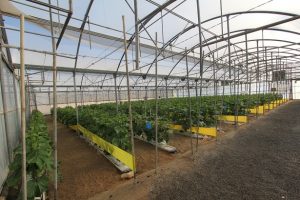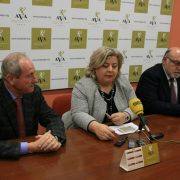Biological control in greenhouse horticultural crops
By Monica Gonzalez Fernandez. Cajamar Experimental Station
The horticultural production of the Mediterranean south-east stands out and is notable for many aspects, but if anything we have been meaning is the rapid adoption of biological control in record time in the main horticultural crops. Since that year 2007, the situation in the use of biological control has evolved and changed a lot. It can be said that biological control saved us from certain death in the markets, and had its peak moments with a sustained increase in the number of hectares produced with biological control each year and the adoption of this technique in a greater number of crops. But currently their employment is experiencing a certain stagnation. What is the reason for this situation? Is it that bugs have stopped working?
“Integrated pest management is our banner, and it can really be said that if there is an agrarian system in which true integrated management of pests and diseases is done, that is intensive horticulture”
The definition of integrated management refers to the use and utilization of all the means at our disposal, putting into practice preventive measures, monitoring insect pest populations and putting in place control measures when the damage thresholds are overcome. Among these control measures the use of natural enemies should be the first tool to be used, but not the only one.
“The integrated management guides allow the use of phytosanitary products, always compatible with the auxiliary fauna when it is considered that the control exercised by the auxiliaries has not been sufficient and may jeopardize the production and / or its quality”
And that’s where we started to find some problems, since really these thresholds of damage are not well defined or established for any crop. The economic threshold of damage is a very complicated parameter and difficult to establish given the amount of factors that can influence, for example the cultivated species, the variety, the cultivation cycle, the cultivation system, the type of greenhouse, etc.
Biological control implies that it is necessary to coexist with a certain pest population, and this is very complex to assume because what is at stake is the destination and the quality of the harvest. The incidence of previously forgotten pests, which are also quite complicated to combat, such as aphids; as well as the appearance of viruses like New Delhi, with such a large dispersion capacity with such a low number of whitefly, aggravates the situation. In such an intensive horticulture it is very difficult to fight all the pests and diseases that occur each year only with biological control. In the market you can find all kinds of products that can help this integrated management, from phyto-fortifiers, biostimulants, zero residue, as well as many agrochemicals compatible with the auxiliary fauna.
“There is no doubt that a very rational use of phytosanitary products is made; the proof is that we have not returned to have phytosanitary alerts in any crop since 2007”
However, it must be borne in mind that the effect of these treatments on the auxiliary fauna is not completely innocuous, which may be the origin of the complaint about the effectiveness of the “bugs”. In my opinion, it is not that the biological control has stopped working, it is that it is required much more than any phytosanitary treatment. It seems that it has been assumed that at some point the active materials that are released and that are available will cease to be effective in a specific time, sooner or later, given the capacity of the pests to generate resistances. However, results are expected from the auxiliaries that are often not realistic.
The truth is that we can not lose perspective and a global vision of the problem is necessary and not particular: biological control always works in the long run. We must bear in mind that its effectiveness is not always the same, because we work with living beings. It is normal and lawful that quick and effective solutions to problems are desired, since there is much at stake, and in this sense biological control involves management and monitoring, which requires time and patience.
It is necessary to look back and reflect on all the benefits that biological control has given us, because the reality is stubborn and, although the current situation has improved infinitely compared to previous years, and the integrated management protocols are respected. We are again suffering from white fly and thrips populations in the field as they did years ago. It is not a whim that biological control is the main tool for the regulation of pests, it is a reality that when we relax in this aspect the problem worsens.
“We have to make an effort and remember at every moment that biological control differentiates us from all our competitors, which is our hallmark and that bugs must always be given an opportunity”
And when I refer to bugs, I refer to all those companies that produce them, and that even with very narrow economic margins, they continue investing money, people and effort in researching and offering new advances and improvements, as well as different solutions to adapt to emerging health problems.
In this sense, both public administrations, public and private research centers, as well as entities closely linked to this sector, such as Cajamar, continue to bet on biological control because we understand that there is no turning back. And not only is there no turning back, but we must continue to bet on biological control in all senses, and implement other biological control strategies that complement and support what is already being done, such as the conservation of native auxiliary fauna .
“The studies on the habitat management and the selection of native species for the establishment of hedges by Cajamar and IFAPA are fundamental for the regulation of pests in the horticulture under plastic of the Mediterranean southeast”
YOU MIGHT ALSO LIKE:
➡️Organic production and production factors

















